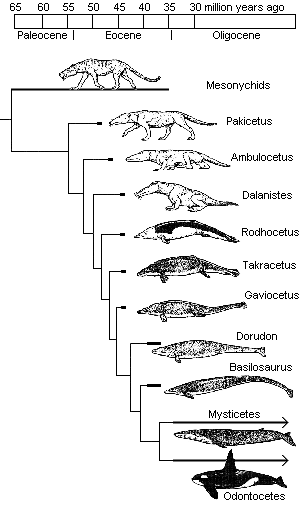
Cladogram for whales.
To illustrate evolutionary history it is often useful to draw a tree diagram known as a cladogram, which shows the times at which various species diverged from each other.
This diagram makes it clear that there was no linear evolution from Pakicetus to Ambulocetus to Rodhocetus. It is just as possible that Ambulocetus descended from a close cousin species of Pakicetus, which diverged from Pakicetus earlier. Given the paucity of the fossil record, it pays to be cautious.
However we can take the various species shown to be representative of the different stages of evolution from land-based mammals to modern whales. We see the various adaptations to swimming, the loss of hind legs, the transformation of front limbs to fins and the development of the tail fluke.
Whales thus provide a prime example of adaptation to an environment over time, beautifully illustrated by the fossil record.
Author: Tom Brown
Copyright: public domain
Date last modified: 11th Oct 2011
Peer-review status: Not yet peer-reviewed
Caldogram: source: http://darwiniana.org/landtosea.htm which was pinched from...Carl Zimmer book, illustration by by Carl Buell, copyright: unknown